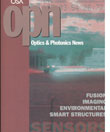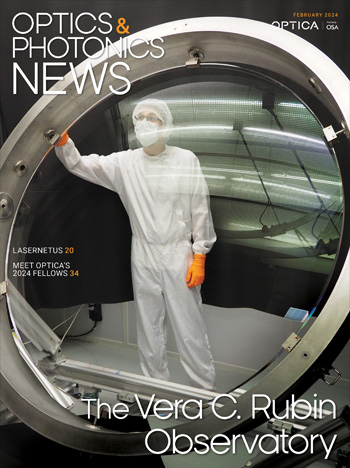
August 1998 Issue
- Infrared Color Vision: An Approach to Sensor Fusion
- Fiber Bragg Grating Strain Sensors: Presend and Future Applications in Smart Structures
- Spectroscopic Environmental Ttace Species Sensors
- Imaging Polarimetry: Applications for Generating Images Where Contrast is Small
- A Guide to the Web
- The Ewald: Oseen Extinction Theorem
- Objective for Fluorescence Microscopy
- Optical Interference Coatings in Nature
- Browse all Issues
Feature Articles
Infrared Color Vision: An Approach to Sensor Fusion
Sensor fusion is the science of combining information from multiple sensor responses. One approach, visualization, fuses various images and adds false color to define features that might otherwise be hidden and to aid the viewer in deciphering a scene.
by Dean Scribner, Prnny Warren, Jon Schuler, Michael Satysher, and Melvin KruerFiber Bragg Grating Strain Sensors: Presend and Future Applications in Smart Structures
Fiber Bragg gratings offer a small, robust, lightweight, and potentially low-cost solution for monitoring structural strain. Their ability to be easily attached to a wide variety of substrates makes them available for many applications.
by E. Joseph FriebeleSpectroscopic Environmental Ttace Species Sensors
Concern over environmental pollutants has spurred the use of trace species sensors in site characterization and field monitoring applications. This article reports on the current uses of these devices.
by E.R. Cespedes and C.E. KolbImaging Polarimetry: Applications for Generating Images Where Contrast is Small
The ability to detect ice on airplanes or roadways and land mines in fields of rubble would save many lives. Imaging polarimetry provides one basis for such detection methods. These and other applications are discussed in this article.
by Blair A. Barbour, Howard B. Barnes, Charles P. Lewis, Patricia E.A. Lindquist, Michael W. Jones, and Neil MohonA Guide to the Web
For scientists and engineers interested in learning about the Web, I can think of no better book than The World Wide Web for Scientists & Engineers by Brian J. Thomas. Thomas has a lot of experience writing about computers and the Internet for technical people—a few years ago he wrote the very useful book, The Internet for Scientists and Engineers. Much has changed since then, however, and the earlier book was in dire need of updating. Thomas has done that very well in this new book, which was published in January. In it he discusses all of the new capabilities brought to us by Web technology—including Web browsers, publishing, and searching for information—while devoting a large section of the book to a listing, by discipline, of thousands of science and engineering resources available on the Web. Thomas writes with a light, readable, engaging style that makes even the most technical aspects of his book a delight to read. If you only read one book about the Web this year, be sure this is it.
by Michael DuncanThe Ewald: Oseen Extinction Theorem
When a beam of light enters a material medium, it sets in motion the resident electrons, whether these electrons are free or bound. The electronic oscillations in turn give rise to electromagnetic radiation which, in the case of linear media, possesses the frequency of the exciting beam. Because Maxwell's equations are linear, one expects the total field at any point in space to be the sum of the original (exciting) field and the radiation produced by all the oscillating electrons. In practice, however, the original beam appears to be absent within the medium, as though it had been replaced by a different beam, one having a shorter wavelength and propagating in a different direction.
by Masud MansuripurObjective for Fluorescence Microscopy
One of the main problems in microscopy is that many objects of interest are invisible under ordinary lighting conditions. Most materials that are opaque and therefore easily seen in bulk form, become nearly transparent phase objects when reduced to sub-micron thickness. One technique for enhancing the contrast of microscopic subjects is to illuminate them with UV light and then observe the emitted fluorescent radiation.
by J. Brian CaldwellOptical Interference Coatings in Nature
When most optikers think of optical interference filters, they think of man-made coatings for controlling light, such as anti-reflection coatings on camera lenses, polarizing beamsplitter cube coatings, and high reflectivity laser mirrors. However, long before humans began using coatings to control light, animals were already wearing brilliant iridescent colors produced by high reflectivity interference filters. In fact, iridescence can be seen in selected birds, fish, insects, mollusks, and even plants
by Jennifer Turner-Valle
![A multiplexed image of a human tonsil acquired. [NIAID] using the iterative bleaching extends multiplexity (IBEX) method.](https://opnmedia.blob.core.windows.net/$web/opn/media/images/articles/2024/0424/departments/202404-cover-web.jpg?ext=.jpg)

